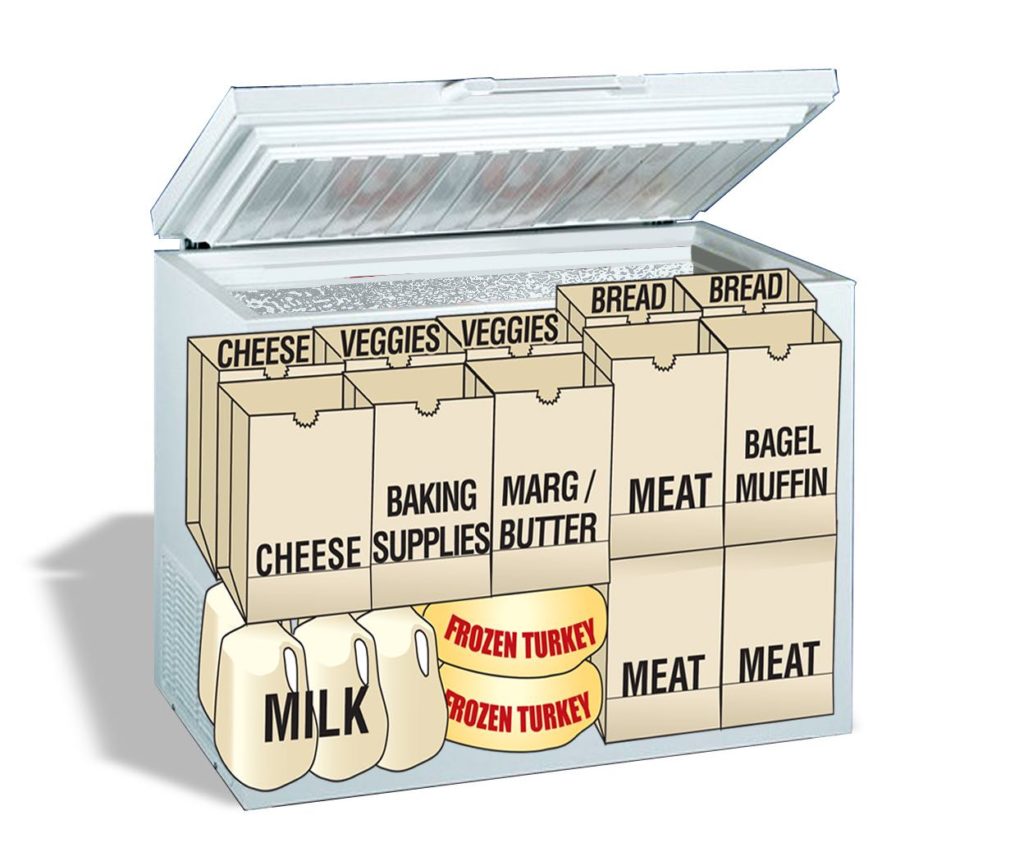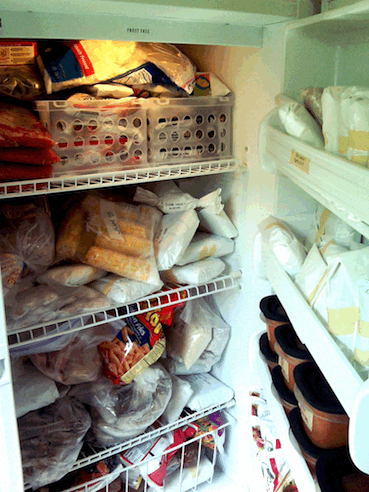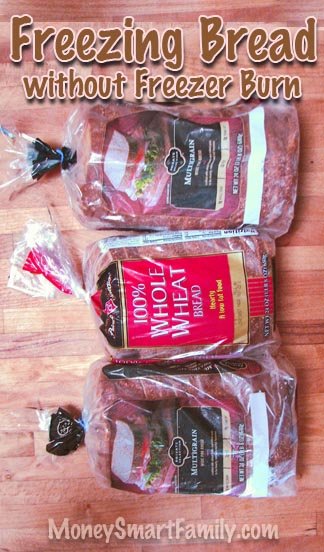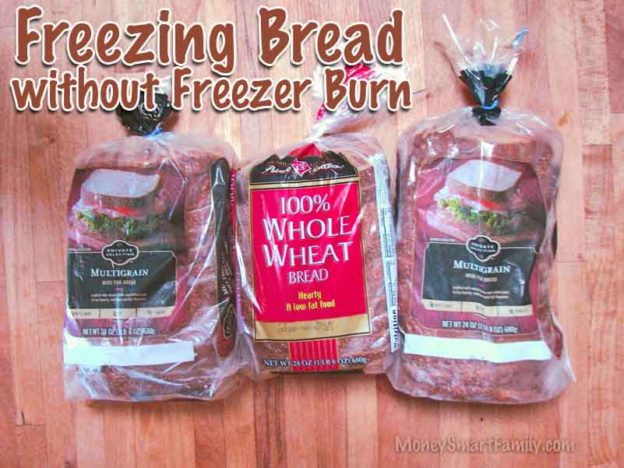Are you looking for easy ways to freeze bread and other options for storing bread? We’ve got simple solutions here, whether you have store-bought bread or homemade bread.
Bread is a staple of life for most of us.
Bread comes in all shapes and sizes. Things like sliced store-bought bread for sandwiches, Artisan bread with thick for dipping, or homemade sourdough bread. Then you’ve got ciabatta, dinner rolls, baguettes, voleos, focaccia, and quick breads.
The sky’s the limit with how many different kinds of bread we bake or consume.
Bread and Being Frugal
Being frugal means that we don’t like to waste the things we buy or make. And we like it to last as long as possible and taste as good as possible too.
When it comes to bread buying or bread baking sometimes you’ll want to freeze it and save it for later.
There are many ways to do this AND to do it while preserving the quality of the bread you have.
How Long Will Bread Last – Unfrozen
TABLE OF CONTENTS
This is a relative question. It all depends on how and where you store it and what type of bread it is.
Thick Crusted Bread
A hearty loaf of thick-crusted bread will last two to three days if stored in a cool dry area in your kitchen.
Storing Unsliced Bread:
According to online food experts at Zingermans, you should store unsliced loaves of bread in a paper bag on your counter.
When you’re ready to eat it, brush the crust with water and place in the oven at 350 degrees until it’s warmed all the way through.
Storing Sliced Bread:
If the bread is sliced, seal it in plastic wrap or a zippered plastic bag.
Store Bought Sandwich Bread
According to EatByDate.com, a loaf of store-bought sandwich bread will last about a 5 to 7 days. This is if you leave it in it’s manufactured plastic bag and on the counter or in a bread box.
How to Keep Bread Fresh Without Freezing
If you want to keep your bread fresh, storing it properly is the key.
We keep our bread either in the refrigerator or in the freezer.But other people swear by storing bread on the counter.
Storing it On the Counter or in a Bread Box
There are a number of ways to store unrefrigerated bread. But most experts agree that bread at room temperature will stay fresh for between two and seven days.
Storing Whole Loaves of Fresh Bread
According to artisan baker David Norman of Easy Tiger Bake Shop & Beer Garden in Austin Texas – you should always buy unsliced bread. Then only cut off what you are going to eat for that meal. Store the uneaten bread with the cut side down on a counter or plate. You can expect to have this bread stay edible for between 2 and 4 days.
Store it in a Bread Box
A bread box merely controls the environment around a loaf of bread. It keeps some moisture in while letting the bread “breathe.” Basically, it slows down the drying out process.
Store your Loaf in a Sealed Paper Bag
A paper bag works much the same way a bread box does. It slows the drying process by preserving some of the bread moisture.
How Long Can Bread Be Stored Unrefrigerated?
The length of time really depends on where you live. In dryer climates, your bread will dry out faster, but won’t go moldy as quickly. You may be able to store bread for a week.
In more humid climates your bread won’t dry out as quickly, but it may turn moldy if left in a dark space too long.
According to StillTasty.com:
- Soft pre-sliced bread will store for about 1 week at room temperature. Bread should be kept in original packaging, and well sealed.
- Soft, unsliced bread will store for four or five days on the counter – unwrapped.
- Unsliced Hard crusted bread will keep fresh for one to two days at room temperature.
How to Store Bread in a Refrigerator
Storing bread in the refrigerator can be a tricky thing. Keeping it cool will slow down the mold process, but the colder temperature will change the consistency of fresh bread.
According to Daniel Gritzer of SeriousEats.com refrigeration of bread speeds up the “re-crystallization” of starch molecules in bread. His research indicated that bread stored in a refrigerator in an air-tight bag still became stale. The bread degraded not due to loss of moisture, but the retrogradation of the starch molecules to the original crystalline structure.
However, Daniel was only testing freshly baked bread made without preservatives.
Now we know that store-bought sandwich bread will usually have preservatives added to enhance freshness.
As a result, we choose to keep commercially “manufactured bread” in our refrigerator. And it usually lasts for 7 to 10 days before it starts to get hard, moldy or go stale. We keep it stored in the manufacturer’s plastic bag with a twisty tie on it. We only buy whole grain bread.
Most serious bread foodies agree that storing bread in the refrigerator is not the best. But they all agree that if you want to keep bread longer storing it in the freezer is the best way to go.
How to Store Bread in a Freezer
According to the bakery experts freezing your bread to make it last longer is a viable option. But is there a trick to freezing bread so that it tastes better?
The Secret to Freezing Store Bought Bread is in the Freezer!
The secret to successfully freezing bread is in the freezer, not the brown paper bags! We use the paper grocery sacks and canvas bags to organize our chest freezer. We put similar items in each bag.
For example, we put each kind of meat in its own bag and have bags for several other categories of frozen food including frozen veggies, frozen fruit, cheese, lunchmeat, and bread, etc.
On page 186 of Cut Your Grocery Bill in Half we put an illustration that shows how we stack our chest freezer with categorized bags and keep it organized.

RELATED ARTICLE: How to Freeze and Defrost Milk
There are four factors to successfully freezing store-bought bread:
- Cooling it first
- Eliminating Air
- The type of bread you’re freezing
- The type of freezer
1. Cool it before Freezing Bread to Keep Moisture In
If your store-bought bread or homemade bread is warm, when you put them in the freezer condensation will form on the inside of the plastic bag.
Instead, you should allow your bread to come to room temperature. Then put it in the refrigerator to cool to around 40 degrees.
And finally, put it into the freezer, you’ll minimize the amount of moisture that leaves the bread and clings to the plastic.
MarthaStewart.com shares a few more details on how to properly cool, then freeze and thaw fresh or store-bought bread.
This step alone will help to keep your bread from drying out when you defrost it.
2. Keep the Air Out
To successfully freeze loaves of store-bought bread or homemade bread while avoiding freezer burn, you’ll need to keep air out and moisture in.
To accomplish this, we snuggly wrap our store-bought bread in a second plastic bag, trying to get as much air out as we can without squishing the bread. We twist the open end of the bag and then tie it to seal air out.
Get more details on removing the air from bread from TheKitchn.com.
Check out two tools to keep your bread tasting better
Chest Freezer – Read this article to learn how much a chest freezer could save you in a year.
See a listing of the top-rated chest freezers on Amazon – they’ll pay for themselves the first year.
Bread Maker – If you’re wanting to make fresh bread – a bread maker is an indispensable tool. It does the kneading for you and makes your home smell delicious. Check out the top-rated bread makers on Amazon.
3. Some Breads Don’t Freeze Well
The type of bread you’re trying freeze is also an important consideration.
Whole wheat bread freezes fine if you put it in a plastic bag and you store it for just a few weeks.
White bread doesn’t freeze well. This is because it has a higher moisture content and when frozen, develops frost on the bottom of the bread. When defrosted, the bread becomes mushy because the frost melts and the water soaks into the bread. However, if you follow step one and cool the bread before putting it in your freezer, you can minimize this problem.
There is also a lightweight wheat bread that we’ve seen in the store that resembles white bread. We have found that this type of wheat bread doesn’t freeze well either.
Developing frost on the bottom of the loaf of bread can happen with whole wheat bread also, but because it is denser, it usually isn’t a problem. Sometimes we put a paper towel inside the actual bread bag as it’s defrosting to absorb moisture and to prevent mushiness.
4. Type of Freezers That Freeze Bread the Best

Another factor in successfully freezing store-bought bread is the type of freezer you have.
Usually, upright freezers are frost free, which means they have a fan that runs constantly to keep frost from forming.
Unfortunately, because the fan is constantly circulating air, it also serves to dehydrate bread, meat and, anything that does not have an air-tight seal. This air circulation in an upright freezer can also cause freezer burn if you leave food items in the freezer for too long.
Visit TheKitchn.com they go into more detail on the problems that frost-free freezers have.
Where to Put Your Bread in the Freezer
We’ve been asked several times, what the best location in a freezer is for freezing bread.
When you freeze bread, where you put it in the freezer won’t matter … unless you’re planning on putting a turkey on top of the bread. The most common problem with freezing bread is getting freezer burn. And usually, freezer burn is the result of storing it too long inside of a frost-free freezer.
This is one of the big reasons we really like chest freezers.
Why We Like Chest Freezers
Most Chest Freezers are NOT frost-free, and as a result, different kinds of foods will store better and longer in the freezer without developing freezer burn.
When it’s time to replace your freezer, consider buying a chest freezer. They can take up a little more floor space, and they do need to be defrosted once a year (or every other year), but they will keep your bread and other food tasting better, for much longer.
This article on eBay compares chest freezers with frost-free freezers. They give the pros and cons of both types of freezers.
How Long Can You Freeze Bread
We’ve stored fresh bread for 6 months when we’ve carefully cooled, removed air and carefully wrapped it. Bread dough will store even longer.
When it comes to freezing bread, a freezer, correctly used, can save you a lot of dough (cooked or uncooked!)
Here is a link to Amazon’s listing of best-rated chest freezers (our preferred type).
Prices for chest freezers range from $170 to $499, and the cool thing is that with an Amazon Prime membership, shipping is free.
RELATED ARTICLE: Panic Buying: New Grocery Strategies for a Pandemic
Buying the Freshest Bread Possible
If you want to keep store-bought bread fresh longer, you want to start with the freshest bread possible. But how can you do that when shopping at the grocery store.
What Do Bread Colored Twist Ties Mean

Some consumer experts say that if you want to know what day of the week your loaf of store-bought bread was baked, look at the twisty tie or colored tab.
We researched this theory to see if it was true. You may be surprised at what we found.
According to Consumerist.com and Wisebread.com most bakeries use the same colored tag system to make it easier for their store stockers to identify older bread and replace it with fresh loaves.
Here’s the color code system they use:
- Monday = Blue
- Tuesday = Green
- Thursday = Red
- Friday = White
- Saturday = Yellow
For some reason, most bakeries don’t bake bread on Wednesdays and Sundays.


